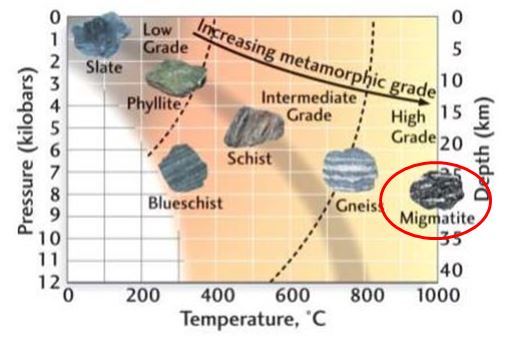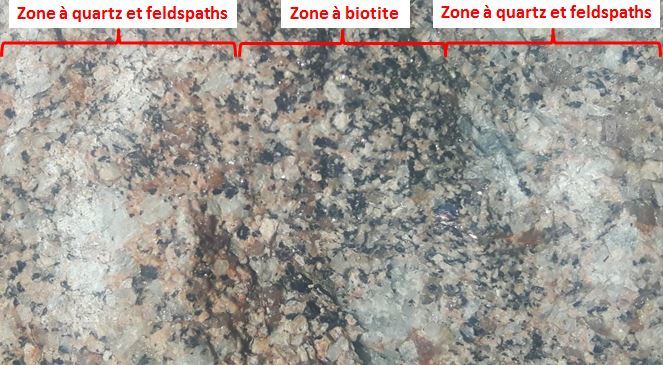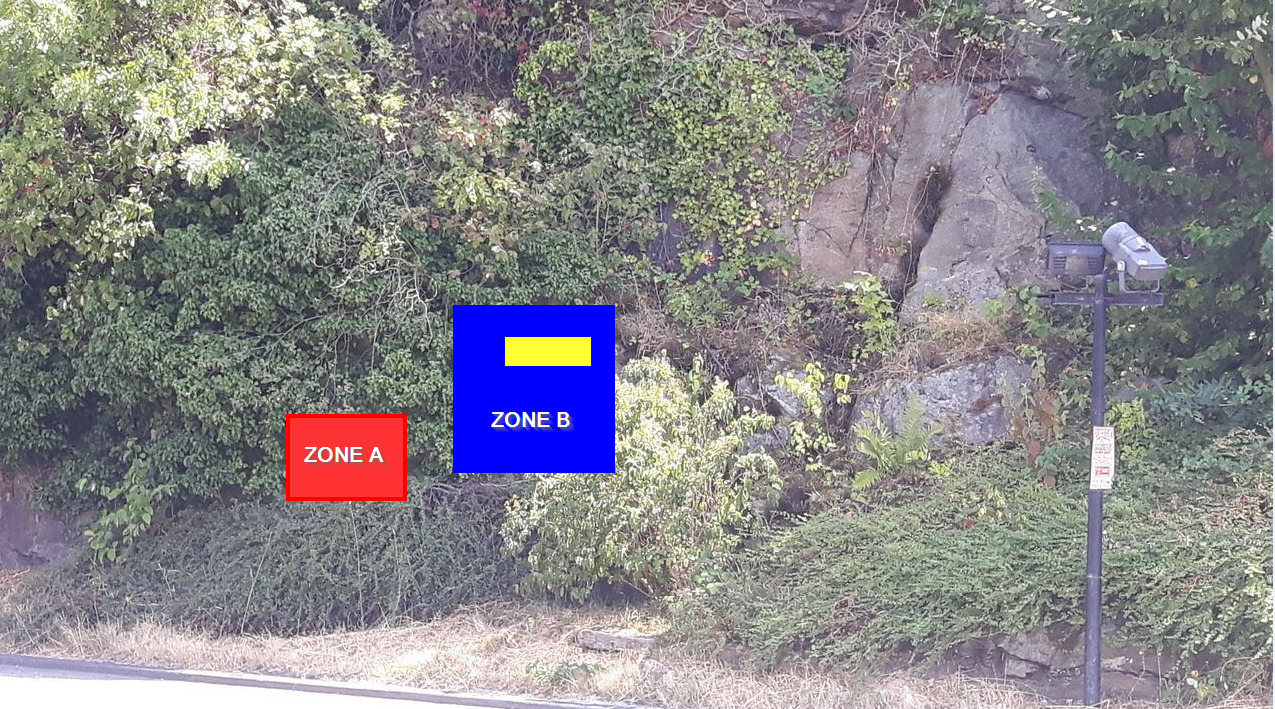
La Earthcache / The Earthcache
Parce qu'il n'y a pas que le grès vosgien en Alsace...
Cette petite série de caches géologiques a pour objectif de permettre la découverte sur le terrain de la richesse géologique du Centre Alsace et d'avoir un court aperçu de son histoire tumultueuse qui a aboutit à la mise en place de cette diversité de roches et des phénomènes tectoniques majeures dont cette région a été l'objet au travers des Ages.
Ce sixième épisode va partir à la découverte d'une formation rocheuse mise en place dans des conditions extrêmes de pression et de température, la Migmatite du Kayserberg.
► Contexte géologique local
L'étude de la carte géologique de la région du massif du Kayserberg, entre Orbey et Labaroche, montre une ensemble de roches métamorphiques prenant place entre le massif granitique du cœur des Vosges et les formations gréseuses des collines sous vosgiennes.

Ces roches secondaires hétérogènes, qualifiées de migmatites au sens descriptif du terme (roches « de mélange »), se composent de matériaux sombres constituant des enclaves enveloppées dans une matrice d'allure granitique, dans des proportions volumiques très variables.
Partons à la découverte de cette formation témoin de conditions de formation des plus extrêmes.
► La Migmatite du Kayserberg, roche métamorphique de haut grade
Une roche métamorphique est une roche secondaire issue de la métamorphisation (transformation sous l'effet de la pression et de la température) d'une roche primaire, qu'on va appeler protolithe.
Ce protolithe peut être une roche sédimentaire, magmatique voire même métamorphique.
~ Qu'est-ce que qu'une migmatite ?
Les migmatites sont régionalement associées à des roches métamorphiques de haut degré.
Il s'agit du stade ultime de métamorphisation (Hautes Pressions et Hautes Températures), avant fusion complète de la roche et transformation en un granite d'anatexie.

Elles sont qualifiées de roches anatectiques issues d'une fusion partielle des roches dans la croûte.
Dans les migmatites du Kayserberg, nous allons donc trouver deux natures de roches :
- Une partie claire, appelée leucosome ou néosome, de texture grenue, quartzo-feldsapthique : c’est le produit de la cristallisation du liquide fondu.
- Une partie sombre, appelée mélanosome ou paléosome et constituée de minéraux réfractaires ferro-magnésiens. Ce sont les résidus solides de la fusion partielle.
~ Deux types de migmatites
D’un point de vue structural, deux types de migmatites sont distingués selon la proportion entre néosome et paléosome :
-> métatexites
Les métatexites sont un premier stade de migmatites, dans lesquelles les structures n'ayant pas subi de fusion partielle (les paléosomes) sont larges et prépondérantes. On observe, en plus faible proportion, une partie ayant fondu (le néosome).
Ces formations se présentent sous une forme rubanée, avec une alternance de lits clairs (partie de la roche ayant fondu) et de lits sombres (partie de la roche étant restée solide).
Cette roche très ductile présente des foliations avec des formes très variées.

-> Diatexites
Les diatexites sont le stade le plus avancé de la métamorphisation de la roche ; ces diatexites ont un aspect granitique prononcé et perte de la foliation. La proportion est inversée entre paléosomes et néosomes : la partie ayant fondue est largement prédominante.
Les cristaux du néosome y sont bien visibles et présentent une structure cloisonnée, quartz et biotite occupant les interstices entre les feldspaths.
On aperçoit aussi des zones plus sombres avec une proportion significative de biotite.

Le paléosome apparaît sous la forme d'enclaves de roches sombres de formes ovoïdes plus ou moins aplaties et de tailles très variées dispersées dans la trame granitique.
On parle ici de restites, résidus du protolithe (ici des Grauwackes du Culm).

► Métamorphisme : formation et transformation
Il y a entre 330 et 325 Ma, les migmatites se mettent en place à la faveur de l’orogenèse hercynienne. Celle-ci va fortement remanier les formations antérieures volcano-sédimentaires, des Grauwackes datant du Carbonifère inférieur (faciès Culm).
Les Grauwackes sont des roches de couleur généralement plutôt sombre, allant du gris ou vert foncé au noirâtre, il s'agit de roches sédimentaires issues de l'érosion d'anciens volcans existants.
Les contraintes tectoniques entraînent un enfoncement des couches et une forte hausse de la pression et des températures, conduisant à la fusion partielle du protolithe.
Cette fusion se fait à des températures de 680 à 700 °C et à des pressions de 3–4 kbar (environ 10 à 12km de profondeur).
Le pic de fusion, entraînant l'apparition des diatexites (disparition de toute trace de foliation synmigmatique) va se réaliser lors de la remontée de la racine de la chaîne de montagnes (gneiss de Sainte Marie) dans les niveaux de grauwackes du Culm.
Because there is not only the Vosges sandstone in Alsace ...
This small series of geological caches is intended to allow the discovery on the ground of the geological wealth of the Alsace Center and to have a brief overview of its tumultuous history which has led to the establishment of this diversity of rocks and phenomena major tectonics of which this region has been the object through the Ages.
This sixth episode will discover a rock formation set up under extreme conditions of pressure and temperature, the Migmatite of Kayserberg.
► Local geological context
The study of the geological map of the Kayserberg massif region, between Orbey and Labaroche, shows a set of metamorphic rocks taking place between the granite massif of the heart of the Vosges and the sandstone formations of the Vosges hills.
These heterogeneous secondary rocks, qualified as migmatites in the descriptive sense of the term ("mixing" rocks), consist of dark materials constituting enclaves enveloped in a granite-like matrix, in very variable proportions by volume.
Let's go to the discovery of this formation demonstration of extreme formation conditions.
► Migmatite of Kayserberg, high grade metamorphic rock
A metamorphic rock is a secondary rock resulting from the metamorphization (transformation under the effect of the pressure and the temperature) of a primary rock, which one will call protolith.
This protolith can be a sedimentary, magmatic or even metamorphic rock.
~ What is a migmatite?
Migmatites are regionally associated with high grade metamorphic rocks.
This is the ultimate stage of metamorphization (High Pressures and High Temperatures), before complete melting of the rock and transformation into a crustal magma at the origin of granite of anatexis.
They are called anatectic rocks because they result from the partial melting of rocks in the earth's crust.
In the migmatites of Kayserberg, we will therefore find two natures of rocks:
- A clear part, called leucosome or neosome, grained texture, quartzo-feldsapthique: it is the product of the crystallization of the molten liquid.
- A dark part, called melanosome or paleosome and made up of ferro-magnesian refractory minerals. These are the residues of the partial melting.
~ Two types of migmatites
From a structural point of view, two types of migmatites are distinguished according to the proportion between neosome and paleosome:
-> Metatexites
Metatexites are a first stage of migmatites, in which structures that have not undergone partial fusion (paleosomes) are large and predominant. In a smaller proportion, a part that has melted (the neosome) is observed.
These formations are in a banded form, with alternating light beds (part of the rock having melted) and dark beds (part of the rock remained solid).
This very ductile rock has foliations with very varied forms, including the characteristic synmigmatitic penetrating foliation.
-> Diatexites
Diatexites are the most advanced stage of rock metamorphism; these diatexites have a pronounced granitic appearance and loss of foliation (original or synmigmatitic). The proportion is reversed between paleosomes and neosomes: the melted part is largely predominant.
The crystals of the neosome are clearly visible and have a partitioned structure, quartz and biotite occupying the interstices between the feldspars.
There are also darker areas with a significant proportion of biotite (black mica).
The paleosome appears as enclaves of dark rocks of ovoid shapes more or less flattened and very varied sizes dispersed in the granite frame.
We speak here of restituts, residues of the protolith (here Grauwackes of the Culm).
► Migmatite of Kayserberg, high grade metamorphic rock
Between 330 and 325 Ma, migmatites are set up in favor of the Hercynian Orogeny. This one will strongly reshape the previous volcano-sedimentary formations, Grauwackes dating from the lower Carboniferous (facies Culm).
Grauwackes are generally rather dark colored rocks, ranging from gray or dark green to blackish, and consist of sedimentary rocks eroded from ancient volcanoes.
Tectonic stresses lead to a sinking of the layers and a sharp rise in pressure and temperatures, leading to the partial melting of the protolith.
This melting is done at temperatures of 680 to 700 ° C and pressures of 3-4 kbar (about 10 to 12km deep).
The peak of fusion, resulting in the appearance of diatexites (disappearance of any trace of synmigmatic foliation) will be realized during the ascent of the root of the mountain range (gneiss of Sainte Marie) in the levels of grauwackes of Culm.
► Sources bibliographiques / Bibliographical sources
Les Questions / The Questions
La lecture attentive du descriptif de la cache, ainsi qu'une observation des éléments de terrain et un peu de déduction sont normalement suffisants pour répondre aux questions de cette EarthCache.
A careful reading of the description of the cache, as well as observation of terrain features and some deduction is usually sufficient to answer questions of this EarthCache.
Questions pour valider :"Les Migmatites du Kayserberg"
Questions to validate: "The Migmatites of Kaysersberg"
Nous voici en dessous de la chapelle Saint Wolfgang assise sur de la migmatite de Kaysersberg.
Traversez la route et remontez là sur quelques dizaines de mètres avec prudence le bas côté jusqu'au WP1 (photo WP1_large). ATTENTION, route circulante, ne pas le faire en groupe.
Here we are below the Saint Wolfgang chapel sitting on Kaysersberg migmatite.
Cross the road and go up there for a few tens of meters carefully down the road to WP1 (photo WP1_large). CAUTION, road running, do not do it in a group.

ZONE A
- Question 1 : Décrivez la partie basse de la zone rouge A (granularité, couleur des cristaux, orientation de ces cristaux, présence de foliations/lits de roche). Peut-on parler de métatexites ou de diatexites ? Justifiez notre réponse.
- Question 1 : Describe the migmatite of the red zone A (granularity, color of crystals, orientation of these crystals, presence of foliations / beds of rock). Can we talk about metatexites or diatexites? Justify our answer.
ZONE B
- Question 2 : Décrivez la migmatite de la zone bleue B hors zone jaune (granularité, couleur des cristaux, orientation de ces cristaux, présence de foliations/lits de roche). Peut-on parler de métatexites ou de diatexites ? Justifiez notre réponse.
- Question 2 : Describe the migmatite in blue zone B (granularity, color of the crystals, orientation of these crystals, presence of foliations / rock beds). Can we talk about metatexites or diatexites? Justify our answer.
- Question 3 : Que voyez-vous sous la zone jaune ? En vous aidant du descriptif, qualifiez cette zone. Quelle est la nature de cette roche ?
- Question 3 : What do you see under the yellow area? Using the description, qualify this area. What is the nature of this rock?
Vous pouvez vous loguer sans attendre notre confirmation,
mais vous devez nous envoyer les réponses en même temps soit par mail via notre profil (
fafahakkai), soit via la messagerie geocaching.com (Message Center).
S'il y a des problèmes avec vos réponses nous vous en ferons part.
Les logs enregistrés sans réponses seront supprimés.Une photo de vous ou de votre GPS sur le site (mais sans les zones d'observation) est la bienvenue, mais n'est pas obligatoire.
You can log this cache without waiting for our confirmation, but you must send us the answers at the same time, by e-mail via our profile (fafahakkai) or by the system of Message Center of geocaching.com.
If there is a problem with your answers we will notify you. The logs recorded without answers will be deleted.
A photo of you or your GPS in Black & White on the site is welcome, but not mandatory.
Rappel concernant les « Earthcaches »: Il n'y a pas de conteneur à rechercher ni de logbook à renseigner. Il suffit de se rendre sur les lieux, de répondre aux questions ci-dessus et de nous renvoyer les réponses.
Reminder concerning "Earthcaches": there is neither a container to look for nor a logbook to sign. One need only go to the location, answer to the differents questions and send us the answers.